THE TAMAKI ESTUARY AND HIGH GROUND EXTENDING TO ORAKEI
The location known as Tamaki would rate as a veritable jewel
for ancient occupation and was often referred to in such terms within Maori
oral traditions. The name itself is derived from Tamaki-makau-rau,
which means, "many people" or "The spouse contested
for us by a hundred lovers". This area of heavy occupation,
stretching along the picturesque Waitemata harbour frontage from the Tamaki
estuary to the Orakei estuary, offered an abundance of sea food or good
arable lands for planting. The area was so abundant and beautiful that there
was a Maori proverb to describe it, which went: "Te pai me te
whai-rama o Tamaki"... "The luxury and wealth of Tamaki".
Given the known history of very ancient occupation there,
it is not surprising that the overland alignment surveying line, from the
Silverdale concretion boulder trig, which crosses the mound at Okura Ridge,
then brushes the western side of North Head Hill, carries on to traverse
the Waitemata Harbour and make landfall at Orakei-Tamaki. The line crosses
Bastion Point and runs through the position of the present day Marae there
on the western side of the Bastion Point high ground and then carries on
to Mt. Wellington, which sits adjacent to the Tamaki estuary.
The region was formerly occupied by the Tamaki people or tribe,
who began to lose their grasp on it by the time of chief Kiwi Tamaki
(1720-1750). He was the son of Te Ikamaupoho and Te Tauhuri,
who were of lineal decent from the ancient Patu-paiarehe. These were
the "Tangata Whenua" (Lords of the Soil) or original people,
who occupied New Zealand for thousands of years before the coming of the
Polynesian-Melanesian Maori warriors. Given this direct genealogical link
from the Tamaki people to the Patu-paiarehe, it is not surprising to find
an ancient Patu-paiarehe trig marker at Bastion Point, which was, undoubtedly,
placed there long ago by ancient astronomers and surveyors.

One of the positions that has survived from the ancient
Patu-paiarehe trig marking system at Bastion Point, appears to be this set
of boulders. This double stone set (with yet another boulder added more
recently) was, undoubtedly, also a solar observatory, which appears to have
used Castle Rock (86.95-degrees azimuth ) on the Coromandel Ranges as its
Equinox rise outer marker and southern end of Moehau Mountain as its Winter
Solstice rise outer marker. It also uses Mt. Eden as the outer marker for
the Summer Solstice sunset (the act of returning fire to the volcano).

At the Winter Solstice, the Sun rises at the edge
of the venerated mountain, Mt. Moehau, and climbs the slope to launch itself
into the sky. This same method was used at two northern solar observatories,
both using Mt. Tutamoe to achieve precise (1) Equinox and (2) Winter Solstice
sunrise fixes on the southern slope of the venerated mountain.

From the stone arrangement, the Summer Solstice sun
descends and lands in the cone of extinct volcano, Mt. Eden, home of the
Patu-paiarehe when Maori first arrived in the Auckland Isthmus. Again, the
act of returning "fire" to the volcanos by using them as sunset
alighting or sunrise launching positions (at Equinoxes or Solstices from
the observers position at a carefully placed solar observatory) was common
practice for New Zealand's first inhabitants. This practice was incorporated
elsewhere in the Isthmus, using Mt. Wellinton as the outer marker, for an
equinoctial rise viewed from the obelisk atop Mt. Albert and for an equinoctial
sunset using a standing stone position atop Stockade Hill. An isolated,
high-country solar observatory at Whakahoro in the central North Island
uses the cone of dormant volcano, Mt. Tongariro, as its equinoctial sunrise
position.
The double stone marker at Bastion Point relates very well
as a centre hub for alignments running between the most prominent volcanic
hills of the Auckland Isthmus and outlying islands or prominent positions.
The local hills within full view of the Bastion Point double stone trig
include Mt Eden, with Mt. Albert tucked behind, Mt. Hobson,
Three Kings, One Tree Hill, Mt. Wellington, Mt Victoria, North Head,
many outlying Islands including Rangitoto, Motutapu, Waiheke, Great
Barrier, etc., with the Coromandel Ranges sitting eastward.

Barry Taylor takes an angle fix onto one of the multiple
targets situated in the Hauraki Gulf or beyond on the Coromandel Ranges.
In the background is the symmetrical volcanic Island called Rangitoto, which
is probably about 5000-years old. Ancient oral traditions speak of a "Rimu"
forest covering the Island in about the year 1150 AD, but this was burnt
off in a volcanic eruption of about 700-years ago, which also covered the
Patu-paiarehe villages and cultivations with about 1-metre of ash on the
adjacent island of Motutapu. The remains of "wood" from the ancient
forests has been found under lava flows at Rangitoto.
There is some controversy related to the origins of this stone
arrangement at that precise position. One Maori spokesperson claims that
the stones were placed there between "1976-78 as a tribute to the
many Kaumatua who had fought to retain this land for Ngati Whatua. They
have not been there from time immemorial, they were sited there during the
occupation. The stones came from somewhere up north".
If this is the case, then were they sited there based upon
expert knowledge of a former nui pole marker or an oral tradition related
to the importance of the spot?
- The spot sits exactly due south of the former, huge "Bastion Rock"
and would have provided a trig for very accurate degree angle orientations
to targets around the horizon.
- The spot provides very accurate fixes onto solar rises and sets on the significant
days of Solstices and Equinoxes.
- The stones appear to have been above ground and in use for a very long time,
as they're deeply covered in untold generation s of lichen.
- Why would stones need to be brought into the Isthmus from "somewhere
up North", when pockets of high quality and durable basalt exist throughout
the Auckland Isthmus?
Despite the double stone trig marker being so conveniently
placed, it is still 210 metres too far off-line to feature as the Bastion
Point's component marker in the ancient overland surveying alignment that
runs from Silverdale to Pukemore Hill in Huntly. As it turns out, the ancient
surveying line passes through the modern-day Maori marae overlooking Orakei
Basin.

The new Meeting House at the Bastion Point Marae. The ancient
Patu-paiarehe surveying line from Silverdale to Pukemore Hill would pass
just slightly to the west of this building. Maori art and symbolism was
derived from the much earlier Patu-paiarehe people, who also taught them
weaving, fish net making, carving wood or stone, haka dance, tattooing and
many other arts, methods or cultural expressions.
THE "FIX" POINT FOR FINDING TRUE NORTH FROM THE
BASTION POINT TRIG.

A view from the Catholic Bishop's residence at St. Mary's
Bay, looks over Mechanic's Bay and the gasworks at the bottom of College
Hill, before major reclamation took place. Where the wharf in the foreground
is seen, Victoria Park now sits. In the background, beyond the growing,
young Auckland City a huge outcrop called "Bastion Rock"can be
seen in the sea outward from Bastion Point. By 1920 or so it was gone, its
rubble supposedly used to build the Tamaki Drive. This large outcrop sat
2640 feet (exactly 1/2 a mile) due north of the ancient "double stone"
trig further inland at Bastion Point. This means that ancient surveyors,
wishing to do 360-degree angle shots from the trig, could pinpoint due north
first by aiming at Bastion rock, half a mile removed. There was, without
doubt, another "true north" fix point on Whangaparoa Peninsula.

Two views of Bastion Rock, shaped like a truncated pyramid.
It's majestic appearance and strategic position suggest it would have been
a highly venerated outcrop to the ancient Patu-paiarehe surveyors who occupied
the region long before the arrival of the Polynesian-Melanesian Maori.

Bastion Rock in its final years, before it was demolished
to provide roading base course. In this scene it has a flag staff atop it,
with a flag barely discernable.

Thankfully the trig marking the alignment from Moir's Hill
(North of Puhoi) to Silverdale to Okura Ridge to Takaparawha
Point - Bastion Point to Mt. Wellington has survived, at least in
part, and reposes fairly close to the old Patu-paiarehe surveying line.
The ancient boulders that formed the cairn trig might have been shunted
a short distance east from their original position on the crown of the hill
to form this garden or path feature adjacent to the Marae medical centre
on Kupe Rd. There is no naturally occurring, high quality basalt like this
in the area and these lichen covered boulders have been brought in and placed
on the sandstone or sedimentary papa high ground at some former time. The
fact that they are found at the "expected" position at the crown
of the hill and on the line of purpose built surveying markers, stretching
from Silverdale to Pukemore Hill in Huntly, then onward to Lake Taupo, suggests
that these boulders have been acquired from the ancient trig marker cairn
adjacent and pressed into service for this gardening function... by someone
who did not understand the reason or purpose of their ancient placement
at the precise former position.

Another ancient trig circle sits in a sentinel position
at the intersection of Coates Avenue and Kepa Road, overlooking the Orakei
Estuary to the south and west Its functioned is yet to be analysed and tested.
The pyramidal shape of the standing stone in the foreground is very typical
of an undisturbed, Patu-paiarehe obelisk trig. From this elevated position
there are panoramic views to the west and south, extending over a considerable
distance. This appears to have been a solar observatory that used Mt. Hobson
as the Summer Solstice sunset outer marker, again returning fire to the
extinct volcano.
THE RED HILL STANDING STONE CIRCLE
In the high country of Red Hill suburb, near to Papakura
township, one of the very ancient Patu-paiarehe "standing stone circles"
still survives. The hubstone of this structure remains at or very near to
its original standing position and is situated 7.6-miles due north of the obelisk
cluster on Mr. Kevin Plummer's farm at Bombay. We know that the Bombay obelisk
stones were moved a short distance out of the path of the new motorway to their
present position. If they were relocated only 35.2 feet further towards
the motorway, then they would sit perfectly due south (180-degrees azimuth
off true north) of the Red Hill standing stone circle hub position. It becomes
apparent that the Bombay obelisks were the "southing" outer-marker serving
the Red Hill observatory site.
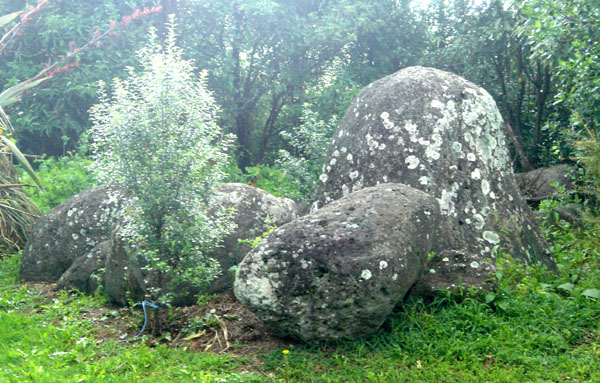
This
huge and visually impressive central stone of the Red Hill standing stone circle,
which rises over 6-feet (2-metres) above ground once stood about 10-feet further
northeast in the middle of, what is now, a concrete driveway. It is surrounded
by both smaller stones and a larger one in a close ring. Directly to the west
and virtually touching this erect stone is a very long and large obelisk stone
that might have achieved a height of 10-feet when standing. It's highly possible
that the now reposing obelisk stone was the original hub. The hub position is
considered to be:
S 37 04' .463", E 174
58' .658" (NZMG 2686185.86, 6456707.05).
The
Red Hill standing stone circle appears to be substantially intact and could easily
be restored to its former, original condition. Beyond the central cluster of obelisks
are the outer component stones, now enveloped by bush and bamboo. Many of these
are very large stones and, although mostly tipped on their sides now, should repose
at their intended positions and need only to be carefully stood up anew in order
to function in their original alignment capacities.
The
pedigree of this site is reasonably well known, especially for the past sixty
years or so. In 1952 the Brown family purchased the farm upon which the standing
stone circle was situated. Mr. John Brown quickly came to the conclusion that
the stones formed a purpose built structure and, during his tenure of the land,
tried to make sure the boulders were never disturbed or dislodged from their original
positions. As stated, a bulldozer driver, against the express wishes and instructions
of Mr. Brown, moved one stone about ten feet and then re-erected it, while cutting
a driveway. Its exact former position is still known by Mr. Brown senior.
I
was made aware of the site by Malcolm Brown of Drury-Pukekohe, son of John Brown
who had purchased the land in 1952. Malcolm used to play amongst the stones as
a child and remembers the respect his father accorded the site. When the farm
was subdivided, Mr. John Brown officially declared this part of the overall farm
to be a reserve, thus ensuring that it could never be built on. He was determined
to preserve the stones in their carefully placed positions for posterity. The
reserve is registered under the legal description: Lot 28; DP89718.
Quite
close to the hubstone cluster is a natural outcrop of bluestone. Nevertheless,
no bluestone seems to have been used in the construction of the standing stone
circle, the components of which are made from very rounded, water-worn basalt.
Far below the site, over sheer cliffs, there is a substantial watercourse and
it's probable the component stones for the site were acquired, at tremendous effort,
from that low lying location.
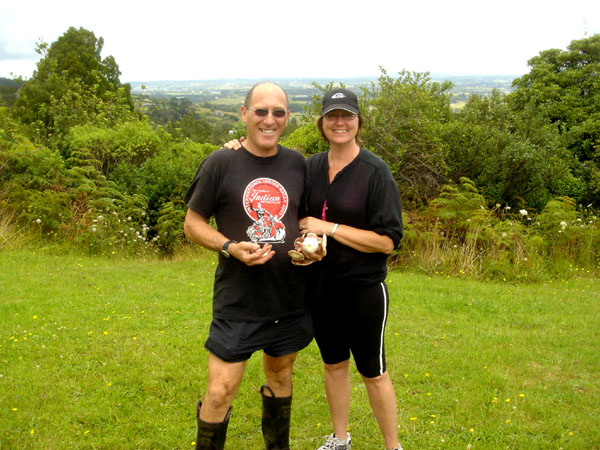
Malcolm
and Vickie returning to Malcolm's old home district and childhood haunts. It is
only through the sharing of memories, observations and conclusions reached by
individuals like Malcolm, that we can begin to piece together the true history
of New Zealand. This photo was taken atop Pukekiwiriki at Red Hill, the top crest
of which features as a crossover target in an ancient alignment between Stockade
Hill in Howick and the conical tor mound (B2D4) at
Mt. William beyond Bombay.
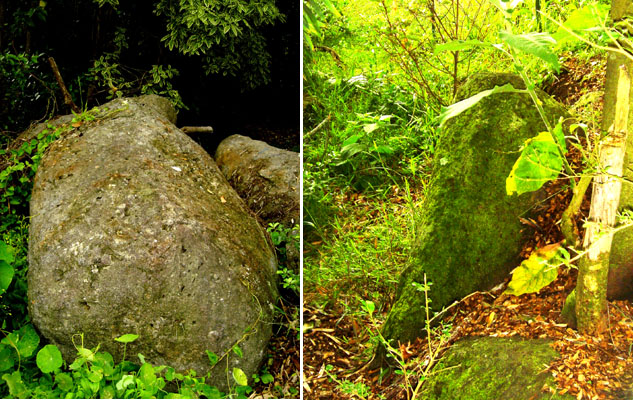
Left:
This is without doubt the single largest obelisk on the site and, when standing,
it would have achieved a height of around 10-feet (3.3 metres). It is quite likely
that this was the original hubstone, as its superior height and girth suggest.
Right:
a very pyramidal marker stands some distance from the hub in the fringes of bush
and bamboo. It is still erect in its original position and probably formed an
alignment from the hub towards Mangere Mountain near the Manukau Harbour. Regrowth
now obscures the clear view in that direction, but the alignment functions of
each marker can yet be determined by careful surveying.
HOW
THE RED HILL STANDING STONE CIRCLE WORKED
The fullness
of what the Red Hill site was set up to do cannot be known until all of the component
positions are identified and their distances and angles from the hubstone are
measured. In a general sense, however, we can state that it was used for astronomy
and overland navigation. To the east of the site is a fairly flat, elongated range,
which would have worked well for solar fixes at the time of the solstices (summer
& winter) and equinoxes (vernal & autumn). Malcolm well remembers the
sunrises over the nearby range during his years of living at the site. Unfortunately,
trees now obscure the former panoramic views in several directions. Both sunrise
and sunset solstice & equinox fixes would have been possible from this site,
as to the west there is a very distant elongated range as well. An adept astronomer,
well acquainted with the dips and bumps along the ranges could gauge, using those
very distinctive geological features or landmarks, the days of occurrence for
the solstices and equinoxes.
Apart from the Red Hill hubstone
lying exactly due north of the Bombay Hill obelisks, the hubstone position also
lies at 24.88-degrees (24 & 22/25ths-degrees) from Pukekohe Hill. This coding
was in mnemonic reference to 24883.2-miles for the equatorial circumference of
the Earth. The Great Pyramid is 756 feet per side or 3024 feet for one circumnavigation.
The distance around the pyramid is 1/2 of 1-minute of arc in a world that was
described mathematically as 24883.2 Greek miles in circumference (24883.2 X 5250
feet). The highly factorable number used by ancient navigators to describe the
circumference of the Earth was 12 X 12 X 12 X 12 X 1.2 = 24883.2-miles. If navigating
using a 6&7 number family, those miles were set at 5250 feet. These angles
between the various sites or markers within individual sites would have provided
tutorials for initiate students in the Patu-paiarehe "schools of learning"
(what later became the Maori wharewaananga).
Note: the British
standard inch and foot are very ancient and in perfect ratio to all of the cubits
or other rods used by the cousin Mediterranean-European nations in remote antiquity.
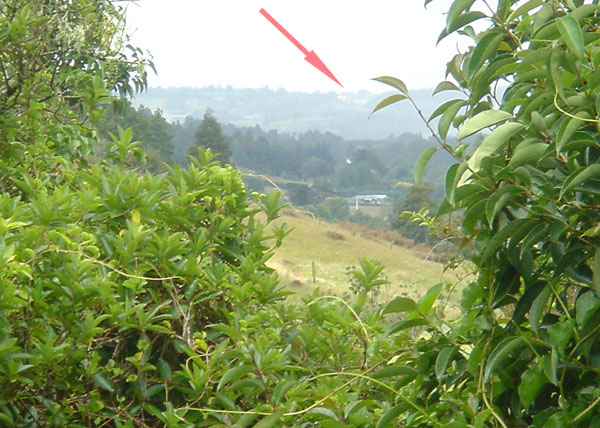
A
somewhat magnified view towards Bombay Hill from the hubstone cluster at Red Hill.
A person with acute eyesight would be able to see the obelisk cluster at Bombay
Hill on a clear day or vis-versa in looking from Bombay Hill back to the Red Hill
hubstone complex. The crown of Pukekohe Hill is also in clear view and it's quite
obvious that the Red Hill site was very carefully chosen in relation to the crown
position of Pukekohe Hill. While these sites are not directly on the dissecting
alignment running from Silverdale, across the entire Auckland Isthmus to Mt. William
(Puketutu), they are appendage sites to that alignment.
ANATOMY
OF A MAJOR TOR MOUND.
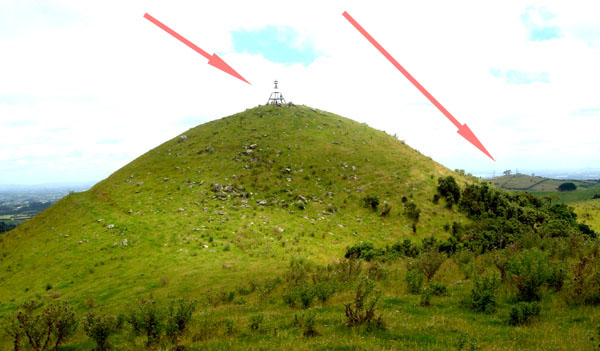
The
huge and highly visible, shaped and built-up hill that served the Waikato side
as a marker mound at the southern fringes of the Auckland Isthmus. An ancient
surveying line extended to this hill from Mt. Albert in the Auckland Isthmus.
The arrow to the right of the picture shows the "double trees" position
of the Bombay tor mound. The line from Mt Albert crosses the summit of that small
tor to resolve onto the summit of B2D4 trig. A second
line began, anciently, at Stockade Hill, which crossed the summit of Pukekiwiriki
Hill in Papakura to also resolve upon B2D4 mound
at Mt. William. Further searching on these alignments through Auckland should
reveal more surviving, ancient interim trig markers.
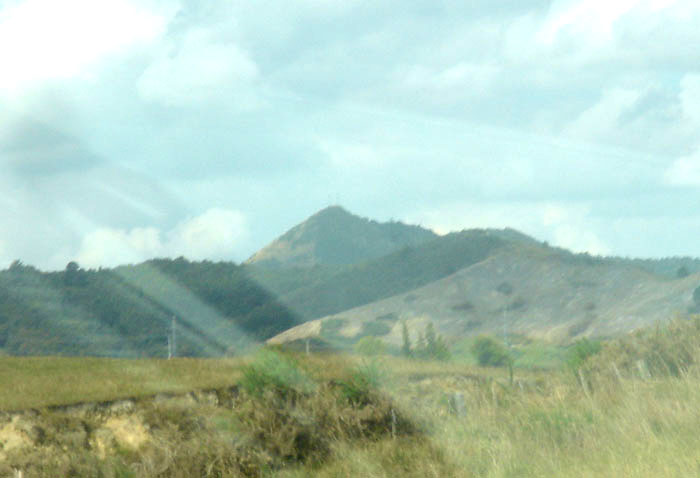
Many
miles to the south of B2D4, and situated east of
Huntly, is Pukemore Hill. Just as this tor mound
at Bombay (B2D4) has been purpose built or modified
and shaped to function as a highly visible surveying trig, so also has the upper
hump section of Pukemore Hill, 26.76-miles further distant. Pukemore
Hill represents the next component structure on the alignment, which has,
so far, been traced from Silverdale to Huntly. Over time we will endeavour to
identify all of the purpose shaped or erected structures on the main-trunk-line,
ancient surveying alignment, running South to Lake Taupo or North to Matauri Bay.
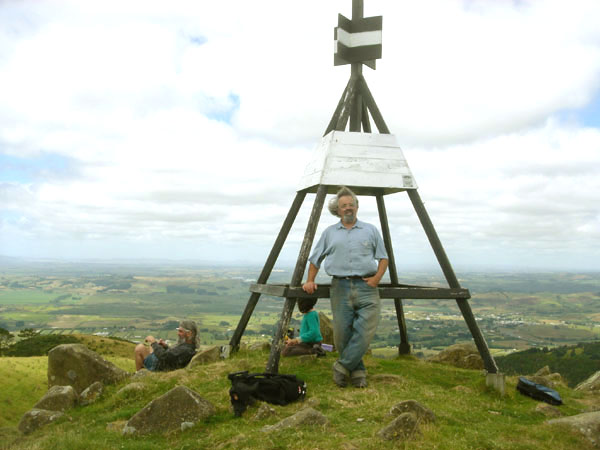
The
author and companion researchers enjoying the panoramic views from atop B2D4 through
360-degrees of vista, which are spectacular. Ancient "directional incising"
on the topmost boulders has now been obscured by modern graffiti artists cutting
their names into the rocks, but further down the hill the ancient "directional
incising" marks on stones are still in evidence.
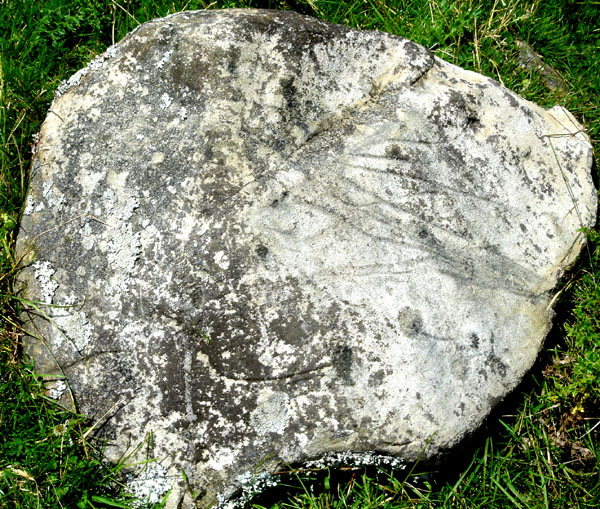
Ancient
incised lines adorn this large flat boulder at the base of B2D4
trig hill. The lines suggest tracks over ridges to places further afield and this
boulder was, quite probably, just another ancient map of the district. Much of
the incising is now covered with lichen. Another ancient arrow design, incised
into a stone nearer to the summit, points directly at Pukekohe Hill.
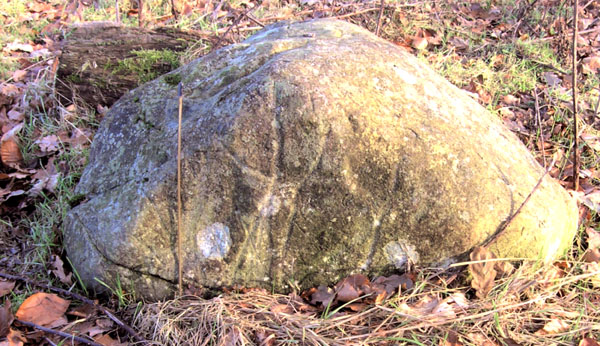
The
long straight-stroke or erratic angle "directional" incising, so typically
found on New Zealand stones, is also found upon this English countryside stone
at Dalemain, near Ullswater, Cumbria, England. (Photo supplied courtesy of T.C.
Bell and taken by him in December 2005).
The point is Aucklanders,
you don't have to travel half way around the world to see standing stone circles
or overland alignment sites. Branches of the selfsame family tree of nations that
built the great megalithic sites of Britain, Continental Europe or earlier edifices
around the Mediterranean Basin, were also living for many thousands of years in
New Zealand and brought all of those cultural expressions to this country in remote
antiquity. It's all here betwixt your feet and "in plain sight".
Continue
